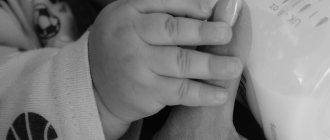Breastfeeding is a wonderful and rewarding experience, but it is not without its challenges. Newborns may have trouble holding onto and learning to breastfeed, and older children who have breastfed well for weeks or months may suddenly stop.
Poor position of the baby at the breast
If your newborn does not latch on well, his sucking will not be effective and he will not be able to get milk from your breast. As your baby becomes more hungry and frustrated, it becomes more difficult for her to breastfeed and she may begin to refuse the breast altogether. When your baby latches onto your breast correctly, he will take your entire nipple and most of your areola, the dark area around your nipple, into his mouth.
Causes
Refusal to breastfeed on one side can be triggered by the physiological characteristics of the mother or baby, as well as the behavior of both during latching. Women sometimes find it difficult to understand why their child behaves this way.
It is important for mom to understand the reasons, but at the same time remain calm. After all, the baby feels even a little stress, and anxiety can affect milk production. If you determine the cause precisely, then in most cases it is possible to solve the problem and establish breastfeeding.
Is more milk being produced on the right or left?
If a baby nurses willingly on one breast but refuses the other, the cause may be uneven milk production. The female mammary gland contains alveoli, which store breast milk. Ducts depart from them and go to the nipple.
Through the ducts, milk enters the baby's mouth during sucking. In one woman, the number of alveoli in different glands may differ, since there are no symmetrical people. There is nothing dangerous or unnatural about this. Each mother, having a different number of alveoli in the mammary glands, is able to feed.
In the gland where there are more alveoli, more milk is collected. It begins to flow as soon as the baby begins to suck. On the other hand, there are fewer alveoli and, accordingly, less milk accumulates. It is produced during the sucking process. Therefore, the baby has to work hard to get food.
On one side it pours more intensely
The baby may refuse one breast and happily suckle on the other due to the different strength of milk flow. Some babies like milk to flow into their mouth. Others prefer to actively suck before doing this.
Nina Zaichenko, certified breastfeeding consultant and famous blogger says:
— The baby sucks on one breast, from where milk splashes directly, and he doesn’t have to strain. And in order to get milk from the other breast, he has to strain and he doesn’t like it. And some children, on the contrary, do not like it when the stream hits his mouth like from a fire hose. Everything is very individual.
Mom places baby differently on both sides
If the baby eats only one breast calmly, but does not want to take the other, then the reason may be the position. It would seem that the mother places the baby on the right and left elbow in the same way. But there is still a difference, and for a little man it is noticeable.
Infants often have increased muscle tone. If it is stronger on one side, then it will be uncomfortable for the baby to lie on a certain side. Because every woman's breast shape is slightly different, it may be difficult for your baby to latch onto the nipple.
The child does not like to lie on one side
The baby, although a newborn, is already a separate person. He shows dissatisfaction in certain cases, but mother does not always manage to understand the reasons. Sometimes babies squabble at one breast and happily suckle at the other.
Premature baby
You may not be able to breastfeed if your baby is born prematurely and requires a hospital stay. Then, once your baby is able to breastfeed, it may take him a while to get started. Small babies have small mouths, so your baby may not have time to cuddle up to your chest until he's a little bigger. Also, a premature baby has less energy to breastfeed, so it may seem like he won't latch on, but he just won't be able to. In the meantime, you can give your premature baby expressed breast milk until he is big enough and has enough energy to latch on.
Reasons for breast refusal in newborns
Nipple shape
A newly born baby may not breastfeed for a number of reasons. Most often there is a whole complex of them. Women's breasts can have a wide variety of sizes and nipple shapes. If the nipples are very flat or sunken, it is more difficult for the baby to drink milk, but most often children do not experience any particular discomfort while feeding. In rare cases, the shape of the nipples can become a truly serious obstacle to feeding.
Anesthesia during childbirth
If the mother gave birth with painkillers, the drugs penetrate into the baby’s blood, which is why the babies are lethargic and sleepy at first. The narcotic substances included in the anesthesia are completely eliminated from the baby’s body only after a few days. Even relatively weak (compared to other modern painkillers) morphine will cause lethargy in a child for several days.
Mucus in the respiratory tract
If your baby's airways are suctioned too much at birth, this may have a negative effect on his or her desire to breastfeed for a while. If the baby was born completely healthy and full-term, there is no need to suck out the mucus.
Structure of the oral cavity
Sometimes children are born with a congenital anomaly of the oral cavity, popularly called a “cleft lip.” Often it looks like a cleft palate with a lip, which is immediately visible. But in some cases, only the palate in the depths of the mouth is cleft, which cannot always be detected during the initial examination.
Incorrect chest grip
Why does a child suckle poorly? One of the reasons is his inability to latch correctly. This does not depend on the shape of the breast and nipples. If a newborn takes the breast incorrectly, the milk is released worse, the baby quickly gets tired and begins to be capricious. Breastfeeding mothers need to ensure proper latching and, if necessary, consult a lactation consultant.
Short frenulum of the tongue
The first reason is purely physiological - the baby’s short frenulum of the tongue. In this case, the tongue is not mobile enough, and the baby finds it uncomfortable to suck. The problem is eliminated immediately after birth; it is enough to show the baby to a dentist or surgeon to make an incision on the frenulum.
Bottle, pacifier
The problem can arise if pacifiers and bottles with nipples are used. The fact is that when sucking milk from a bottle and the mother's breast, different muscle groups are involved. The difference is that milk flows freely from the bottle; you don’t need to make any effort to get it. Breast milk has to be obtained. In this case, you will have to re-teach the baby to latch on to the breast.
Your child has a birth injury or disability
If your baby experiences pain from a broken shoulder or bruises during labor, he may not feel comfortable breastfeeding. In addition, newborns with neurological or physical disabilities at birth may be unable to breastfeed, or they may refuse to breastfeed.
Babies usually use both breasts, but some babies may prefer to drink milk from only one. What is the reason for such taste preferences?
Reasons for one-sided breastfeeding
The reasons for one-sided breastfeeding may be the following factors:
- Uncomfortable position for feeding. Babies may prefer one breast if they are not comfortable on the other side.
- Ear infection or nasal congestion. Health problems like these can cause discomfort when feeding on one side.
- Lack of milk. Sometimes women may have less milk in one breast than the other. This also affects the baby's preferences.
- Nipple injury or crack. In this case, the woman herself may prefer to feed the baby from one breast until the other heals. may prefer to feed the baby on the other.
- Recurrent mastitis or blocked ducts. These conditions can cause pain when feeding on the injured side.
- Physical disability. Some women may find it difficult to hold their baby on one side due to physical differences. The baby may also be reluctant to turn his head in one direction or another (due to position in the womb, trauma during childbirth, etc.).
Does the baby get enough milk from only one breast?
It’s quite possible if a woman takes regular breaks at regular intervals.
However, if there is not enough milk in the breast, the baby may not receive enough nutrition.
How can you tell if your baby is getting enough milk? According to the following characteristics:
- You changed at least five completely wet disposable diapers or six completely wet cloth diapers in 24 hours.
- Urine is odorless and clear.
- The baby is gaining weight and growing.
- The child has good muscle tone.
- The child has normal skin color.
- The child has normal skin turgor; You can test this by lightly pinching your baby's tummy and then releasing the grip. Everything is fine if the skin returns to its place.
Side effects of single-sided breastfeeding
Single-sided breastfeeding can lead to:
- Nipple crack. This is one of the main problems that a woman may encounter when her baby “eats” only one breast. One nipple may become sore and cracked due to continuous sucking.
- Painful breasts. A woman may feel pain in both breasts. While one of them will cause discomfort due to a cracked nipple, the other will cause discomfort due to the arrival of milk.
- Swollen breasts. This occurs on the breast, which the baby refuses. It may become hard and tender from excess milk, and the nipple may become flattened and firm.
- Blocked duct. Failure to remove milk from the less preferred breast can lead to blocked milk ducts. A woman may also notice a painful lump and redness on her breast.
- Mastitis. This is an inflammation of the mammary gland due to stagnation of milk. Initially, mastitis may not be infectious, but if it persists, a bacterial infection is just around the corner.
- Breast abscess. This is a painful swelling and formation of pus on the chest, which happens if mastitis is not treated in time.
How to get your baby to eat from both breasts?
If you are not experiencing pain, bleeding or severe cracking in your breasts, you can encourage your baby to drink milk on both sides by following the tips below:
- Offer the less preferred breast first or when baby is sleepy.
- Massage your less preferred breast; this can increase blood flow.
- You can use a nipple shield if this is the case.
- You can try moving your baby from his preferred side to his non-preferred side without changing his head position. This is useful if the child is reluctant to turn his head in a certain direction.
If a baby eats from only one breast, will the bust become uneven?
You may notice lopsided or uneven breasts if your baby is feeding on only one side. Preferred breasts may be more prominent than others.
Even those women who usually feed their babies from both breasts may have uneven breasts after feeding their babies from one breast.
Unevenness can also occur if the rate of milk production is different on both breasts.
Breast curvature is normal in breastfeeding mothers and is more noticeable during the first few weeks after birth. Although some women may be concerned about this unevenness, in most cases it is unlikely to be noticed by other people.
When should you see a doctor?
If you notice any of the following signs, contact your doctor:
- pain in the nipples or breasts;
- bleeding from the nipple;
- cracks in the nipple;
- red, tender bumps on the chest;
- orange peel skin texture;
- low milk supply;
- the child pees less;
- poor child growth.
A doctor can diagnose the cause of one-sided breastfeeding and make appropriate recommendations. He may also prescribe additional milk formulas for the baby if the baby is not getting enough milk.
References:
- Nationwide Breastfeeding Goals; Centers for Disease Control and Prevention
- One sided breastfeeding; Australian Breastfeeding Association
- Is my baby getting enough milk?; Australian Breastfeeding Association
- Management of breast conditions and other breastfeeding difficulties; The World Health Organization
- Ing R, Petrakis NL, and Ho JH; Unilateral breast-feeding and breast cancer.; The Lancet (1977).
There is a delay in breast milk production
For first-time mothers with certain medical conditions, it may take several days for breast milk to come in. This delay can be distressing for you and your newborn. And when a newborn becomes frustrated, he may begin to refuse the breast. But don't be upset. Breastfeed your baby as often as possible, and if you have to supplement with formula during this time, don't feel guilty.
The child refuses the breast. Don't panic!
Maybe someone will also find this article useful 
The child refuses the breast. Don't panic! Sometimes, immediately after birth, the baby does not take the breast or sucks it for a very short time and throws it away crying. The same problems can arise some time after the successful start of breastfeeding: the baby suddenly begins to worry and refuses to breastfeed.
If a strike occurs in a baby older than 4–6 months, many mothers quite calmly accept this situation as natural weaning and stop breastfeeding. Some, completely unaware of how to cope with this, pump for a long time and feed the baby breast milk from a bottle. But there is another way - to understand the reasons for the child’s refusal to breastfeed. With a certain amount of patience and perseverance, it is almost always possible to convince the baby to return to the breast, and mother and baby continue to enjoy all the benefits of breastfeeding. THE CHILD REFUSES THE BREAST. HOW DOES THIS HAPPEN? It is very important to understand what is happening to the child. After all, breastfeeding is one of the most accessible ways for a baby to tell his mother: “there’s something wrong with me” or “you’re doing something wrong.” Sometimes a strike begins suddenly, sometimes gradually. Refusal usually lasts from 1-2 to 4-7 days, although it can be longer. But giving up the breast does not necessarily mean the end of breastfeeding. It is worth mentioning right away that if the baby is less than 1.5–2 years old, he is not yet ready to complete breastfeeding. Psychological readiness will come later, and, in case of refusal, breast sucking is replaced by attachment to an object (pacifier, bottle, finger). This habit can then persist for a long time. If there is no natural decrease in milk production (involution of the mammary gland), then the woman becomes uncomfortable with overfilled breasts and, in fact, the mother is also not ready to complete breastfeeding. In addition, there is a risk of duct blockage (lactostasis) or inflammation (mastitis). And, of course, the main problem that confronts a woman whose child “went on a hunger strike” and refused to breastfeed is how to feed the baby. REASONS FOR A CHILD'S REFUSION TO THE BREAST The reasons for a child's refusal to breastfeed can be divided into 3 main groups: 1. Refusal of a newborn to suck on the mother's breast when the first feedings were from a bottle or a pacifier was used. 2. Temporary refusal of an older child, when the baby fed well at the breast for some time, and then stopped taking it. There are specific reasons for this behavior of the baby, they can be quickly found out, eliminated, and then continue successful breastfeeding. 3. Cases when the baby “refuses his mother” are stable behavior of the child, which means that the psycho-emotional connection between mother and baby is broken and it takes time, patience and a strong enough desire of the mother to regain the child’s trust and continue breastfeeding. The refusal of a newborn to suck on his mother’s breast stands out as a separate large category because the first negative feeding experience, especially in combination with the mother or child’s illness, causes fear of breastfeeding. A woman may feel frustrated, helpless, and worry that her child is rejecting her. There may be a feeling of guilt because, as it seems to her, she did something wrong. Meanwhile, it is quite easy to wean a baby to the breast at this age. Sometimes the help of a specialist is desirable, but the main thing is not to lose hope. A CHILD REFUSES THE BREAST: WHAT TO DO? If a newborn (or older child) refuses to breastfeed, you need to find the reasons for this behavior. First, you should find out whether the child was given a bottle or pacifier? Using pacifiers and feeding bottles is the most common reason for breast refusal. If a pacifier was given in the first days of life, this leads to the fact that the baby may refuse to take the breast altogether or will suckle reluctantly, not for long, and show anxiety at the breast. Sometimes a mother begins to think that she has an unfortunate nipple shape or has little milk. In fact, the reason is different: the mechanism of sucking a pacifier and a breast is very different, completely different muscle groups are actively working, and the child develops “nipple confusion.” In the future, this leads to the baby choosing the most convenient method of sucking for him. Some babies choose the breast, refusing the pacifier, while others combine both the breast and the pacifier. But still, most children choose the latter. In any case, the use of a pacifier and bottle leads to separation between mother and child, when the mother offers the child an “artificial sedative” instead of a breast. In addition, correct attachment is gradually (or immediately) disrupted, which leads to problems with the breasts (painful feeding, abrasions, cracks, lactostasis, mastitis, lack of milk). What to do? First of all, avoid using pacifiers and pacifiers. If a child needs supplemental feeding, it is better to give it from a spoon, pipette or syringe without a needle. Try different methods and choose the most convenient one for yourself. At the same time, it is necessary to increase the time the baby spends at the breast, and proper attachment and comfortable positions for feeding should be specially trained. The time required to retrain a child may vary. In general, the younger the child, the easier it is to wean him off bottle feeding. If the baby cries, turns away from the breast and demands a pacifier, you need to know that this is just his habit. APPEARING BREAST REFUSION Sometimes mothers of newborn babies call the child’s behavior when he turns his head and seems to turn away from the breast as breast refusal. In such a situation, the woman must orient the baby and skillfully attach him to the breast. Or it happens at times that the baby takes the breast, then throws it away, looks for it again and still cannot grab it well. This is normal and does not mean at all that the mother has an unfortunate nipple shape or that the baby urgently needs to be shown to a neurologist. Neither mother nor baby have the innate ability to attach correctly, and for about two weeks after birth, both will have to learn this. The mother needs to gently hold the baby's head with her hand so that he does not turn it, and patiently place the baby to the breast. Later, the baby will be able to take the breast independently for feeding. Sometimes it happens that during feeding, the baby stops, listens to something happening inside, pushes out the breast and begins to grunt, fold his lips into a tube, stick out his tongue, as if teasing or showing disgust. This is also normal - the baby listens to internal processes, concentrates to poop, pee, or demonstrates readiness to burp. There is no need to understand these signs as if the mother’s milk tastes bad and the child refuses to feed. In this case, you should leave the baby at the breast and wait patiently until he is ready to return to his meal. Infants aged 4 to 7 months can be difficult to keep at the breast during periods of wakefulness: the baby sucks little by little and is distracted by any rustle. At the same time, he actively drinks mother's milk before falling asleep and after waking up, and also increases the number of nighttime feedings. This behavior is normal, and neither the weight nor the development of the child is affected. TEMPORARY BREAST REFUSAL Sometimes occurs due to a painful condition of the child: Pain in the mouth from teething, a wound, or a fungal infection such as thrush can cause painful feeding. Inflammation of the ear, where the baby may experience pressure or pain that gets worse with feeding. The baby is uncomfortable in the feeding position, perhaps in pain due to an injection or injury. Feeling unwell due to infection sometimes reduces appetite. The baby arranges a “therapeutic fasting” for himself. The baby begins to get angry and cry if a runny nose interferes with breathing during feeding. The baby is not hungry or has received too much supplemental feeding. Prematurity, immaturity of the baby's sucking reflex. The child is under the influence of sedatives, painkillers after surgery, labor pain relief or due to treatment by the mother. What to do? Check whether the baby is comfortable for feeding, whether he is attached correctly, and whether it is comfortable for the mother. Make sure your baby is healthy. Perhaps he needs to be changed. In case of illness, consult a doctor. If your baby is unwell, feed him often and little by little, as required. If sucking causes pain in your baby, you can arrange feeding with expressed milk from a spoon. When the baby gets a little stronger, switch to the usual way of feeding - from the breast. The condition of the mother and the environment also significantly influence the behavior of the child at the breast: Illness or general malaise of the woman. Breast problems: lactostasis, mastitis, breast engorgement, cracks and inflammation of the nipples of the mammary glands. Cracked nipples can form as a result of improper feeding technique, hypovitaminosis, or general weakening of the woman’s body. Sometimes the baby cannot immediately adapt to changes in the breast or the taste of milk. Be patient, treat your breasts and continue feeding. If the baby cannot suck milk from an overfilled mammary gland, massage it gently, express a little and offer it again. Changes in the emotional state of the mother due to the onset of the monthly cycle, a new pregnancy. A lactation crisis (temporary lack of milk) or excess milk can cause anxiety in a baby and, as a result, breast refusal. Unusually long separation from mother. Strong (emotional) reaction of the mother to painful feeding or the environment (conversations, arguments), moving or traveling. Overexcitement, stress, tension from a busy day or disruption of the usual environment in the house. What to do? To make your child comfortable, try to distract yourself from all external factors and enjoy communicating with your baby. Take the most comfortable position when applying. You can turn on soft music and drink a warm drink before feeding. All this helps you relax and tune in to a pleasant, leisurely feeding. After all, the mother’s condition is most directly transmitted to the child. Follow the rules for successful breastfeeding. Feed your baby frequently, on demand, and do not pump unnecessarily. To soften cracks and inflammation of the nipples of the mammary glands, use ointments based on lanolin, since other products (vaseline, vegetable oil, etc.) can not only cause allergies in the child, but also indigestion; It is necessary to lubricate the breasts after feeding, then the next time the baby is applied to the breast, the ointment will be partially absorbed into the skin and partially washed off with water. If your baby refuses to latch on for any reason, try sprinkling breast milk on his tongue. Often, having felt a familiar taste, the baby readily begins to suck. If this does not help, but you are confident that the baby is healthy and that all external causes that could cause breast refusal have been eliminated, you can wait a little with feeding. It is likely that after some time he will become hungry and the problem of breastfeeding will be solved. OTHER REASONS FOR BREAST REFUSAL There are other, less common reasons for temporary breast refusal: the baby’s sensitivity to the food or medications consumed by the mother (including vitamin and mineral complexes, fluoride preparations, dairy products, caffeine), to nipple creams and ointments, a reaction to a new detergent (soap, shampoo, washing powder), which the baby can feel “through” mother’s skin or clothes. Naturally, not all children react to these situations by refusing to breastfeed. Some babies are more sensitive, others less so: one baby will continue to feed well, another will become capricious at the breast, and a third may refuse to take it at all. In any case, temporary refusal is usually a short-term phenomenon, which is a natural and the only way available to the child to say “no” to his mother, to declare his disagreement with her actions. WHAT ARE THE MAIN MISTAKES IN CARE? Feeding on a schedule, limiting feeding time, repeated refusal of the mother to feed the child when he wants. There is not enough physical contact between the mother and the baby, the child is not picked up enough, there is separate sleep and there are no night feedings. Repetitive stress perceived as a threat. Rough actions, inept manipulations, traumatic procedures, cruelty. • Lack of sensitivity of the mother to the needs of the child, there is no adequate response to the crying of the baby, the child is left alone. GENUINE BREAST REFUSAL If a mother makes the above mistakes, the baby may lose faith in her reliability and react with a genuine refusal. The slightest reason is enough to provoke him. This could be a mother’s absence or a trip to the clinic, the arrival of guests or a massage course... As a rule, within two weeks before the start of refusal behavior, some event occurs, in its own way the last straw that overflows the cup, and the baby goes on strike. A child’s behavior is an expression of his attitude towards his mother. Depending on the severity of the violations, the baby behaves differently. If he sometimes takes the breast, then this is a protest against his mother’s actions, an attempt to “re-educate” her. If the child does not take the breast at all, this is an ultimatum, a real “rejection from the mother,” which can be recognized by six signs: the child does not take both breasts; takes one breast well, but refuses the other; sucks only in sleep; the baby sometimes latch onto the breast, but does not suck or swallow milk or sucks very sluggishly; behaves restlessly at the breast, sucks a little, then quits, cries, starts sucking again, quits again, turns away, arches; the child does not fall asleep (calm down) at the breast, but is consoled by sucking his own fists. Most mothers have a hard time with rejection, experiencing a deep sense of guilt in front of the child, confusion and helplessness. However, panic and guilt are bad allies in this matter. HOW TO OVERCOME GENUINE FAILURE? First of all, it is necessary to understand why it happened and find its causes. Note that this is not always easy to do; an inexperienced mother, as a rule, does not notice her mistakes. In this case, a lactation consultant can come to the rescue and help find the reasons and reasons for refusal and, if possible, eliminate them. It happens that the causes cannot be eliminated. After all, we cannot change the past, but, having realized our mistakes, we are able not to repeat them in the future. Remember that in each specific situation a person chooses the best of all the solutions available to him. Then you didn’t know how to do the right thing, and there was no person nearby who could help, teach, or correct you. Try not to blame yourself for mistakes made in the past, look forward. First of all, the child needs your sympathy and understanding. He's feeling bad now. It's not easy for you either. Believe that if you act confidently, without doubting that you are doing the right thing, and follow all the recommendations, everything will definitely work out, and soon you and your baby will enjoy your newfound intimacy. FIRST STAGE OF ELIMINATING BREAST REFUSION (PREPARATORY) Dealing with refusal is not easy, so try to finish urgent matters and get support. Ask relatives to take on household responsibilities for two to three weeks so that you can devote all your time to the child. Try to explain what and why you are going to do, and ask not to interfere for at least three weeks. It’s good if there’s a woman nearby who can, after listening to all your complaints, say something like: “Still, you’re great. You're doing the right thing. Everything will definitely work out.” It can take from several days to several weeks to prepare the rear. Every day matters, so don't drag it out too long. SECOND STAGE OF ELIMINATION OF BREAST REFUSION (MAIN) At 2-3 weeks, the woman tries to be completely alone with the child and restores the lost relationship, providing the baby with conditions that most closely resemble the state of intrauterine comfort. Throughout this period, she spends a lot of time with the child in her arms and lying with him in an embrace. Often the mother practically never leaves the room or even the sofa. When she leaves the room, she takes the baby with her. Anything that can distract the child from his mother is excluded: walks, visits, visits, visits to the clinic, massage. All objects for sucking are removed forever: pacifiers, nipples. If you previously fed your baby from a bottle, then learn to do it with a spoon. You can move on to this gradually, over 3-4 days. Then remove the pacifier. If the baby is under two months old, forget about it right away. If the child is older and accustomed to the pacifier, leave it on for a few minutes before falling asleep, then remove it completely. In the future, you should ensure that the child always falls asleep with the breast. If the child receives supplementary feeding, it is reduced. This should always be discussed with an advisor. Monitor the child’s condition by the number of urinations. The breast is offered to the baby with frequency depending on age, gender and type of refusal. Always offer the breast before bed, upon waking, and whenever you become restless. When offering breasts, do not insist. If the attempt fails, reassure the baby. The baby should not be allowed to cry under the breast. If this happens, cover your chest, distract and calm him down. While sucking, do not remove the breast until the baby releases it himself. Usually, if the mother fulfills all the recommendations, after 3-5 days the baby begins to give up its positions. The fight against the refusal is completed if the child himself asks for the chest. But the process of restoring the torn psycho -emotional connection should be continued for at least two weeks. The third stage in eliminating the rejection of the breast (consolidating the results achieved) in order to fix the achieved, be vigilant. The kid, who at least once experienced doubts about the reliability of his mother, needs prolonged rehabilitation. Most likely, he will also want to check you for reliability more than once, he will behave provocatively. Therefore, mom should arrange for the baby checks for “loyalty” and offer the breast on his initiative 1-2 times a day. Of course, errors are made due to errors and ignorance of the baby's needs. And in each such case there is an opportunity to fix everything. Mom’s actions should be aimed at prove her reliability, love and willingness to always come to the rescue. Remember that your desire, love and perseverance can work miracles. In conclusion, it is worth noting the following: rejection of the chest is not a reason to stop breastfeeding, but an occasion to think about whether you are doing everything right. This is also important in the case of a one -time refusal. If the baby refuses the chest, it is always worth fighting for the continuation of breastfeeding, but after eight months, it is more difficult to cope with the refusal. It is not easy to deal with refusal. But your efforts will be justified. After all, we are talking about the continuation of breastfeeding - the foundations of your relationship with the child, the foundations of his relationship with the world and other people. Ahead of the whole life, help the baby not to lose faith in you at the very beginning of the path! Feed with joy! Tatyana Davidovich, consultant on breastfeeding and natural care of the child.
Your child wants to sleep
Newborns tend to be very sleepy in general, but the birth process and medications you may have received during labor can make you feel even more sleepy than usual. Jaundice or other illnesses may have a similar effect. If your baby is sleeping, he is not breastfeeding. To wake your baby up, you can rub his legs or back, turn him around, or change his diaper right before or during a feeding. Continue to try to put your baby to the breast as often as possible. Fortunately, the drowsiness is usually temporary.
Why older children refuse breastfeeding
Older children who have breastfed well for some time sometimes suddenly stop breastfeeding. Here are the reasons why an older baby might choose not to breastfeed.
- Colds: Breastfeeding a sick baby can be a challenge. If your baby doesn't feel well or has a stuffy nose, it may be difficult for her to breastfeed and breathe at the same time.
- Distraction: As babies get older, they become more curious about the world around them. Older babies are more easily distracted and sometimes there are simply too many other interesting things they would rather do than breastfeed.
- Fast eaters: Older children eat much faster than younger ones. An older baby can often get a large amount of breast milk in just a few minutes
- Low milk supply: If you are not producing as much breast milk as you used to, your baby may become frustrated with breastfeeding and stop breastfeeding.
- Pain: If your baby is teething, has an ear infection, or has oral thrush, it may be painful for him to latch on. If your baby has colic, he may experience discomfort from gas, bloating, and digestive problems, which can also interfere with breastfeeding.
- Taste: Hormonal changes after your period returns, a new pregnancy, or starting birth control pills can affect the taste of your breast milk. Smoking cigarettes before breastfeeding or eating certain foods can also change the taste of your milk. If your baby doesn't like the taste of your milk, he may not want it.
Baby refuses one breast: consequences
Many women during lactation face the same problem when the baby takes only one breast and completely refuses the other. In this situation, the mother has two options: retrain the baby or obey his wishes.
If a mother wants to continue breastfeeding, then she should try all the ways that can correct the child’s behavior. When a nursing woman submits to the wishes of the baby and agrees to feed only the right or left, then this is a step towards refusal.
If the baby refuses one breast and suckles on the other, and the mother does not try to correct the situation, then the consequences will be as follows:
- In the “unloved” breast, milk will stagnate. This will cause bumps to appear. If you feed the baby only on the right or only on the left, then signs of lactostasis will not take long to appear.
- In one breast, milk will be produced in the same volume, and in the other its production will become less. Over time, the baby will lack nutrition as the child grows. The mother will be forced to supplement the baby with formula because there is not enough milk.
- The “favorite” gland will be larger in size, since it supports active lactation. It is possible that after discontinuation of breastfeeding, the size will be restored, but the skin will still remain more stretched. One breast is larger than the other - a fairly common occurrence when breastfeeding.
What to do if your baby doesn't latch on
Even if it's difficult, try not to worry. Stress can reduce your breast milk supply. Here are some ideas to help solve this problem:
- Breastfeed your baby in a quiet, dark place, away from distractions.
- Seek help and support from your doctor, a lactation specialist, or a breastfeeding group in your area. Bring your child to the doctor to be checked for any health problems.
- Express milk by hand or with a breast pump to maintain your milk supply. Give your baby your expressed breast milk or bottled formula while continuing to offer the breast.
- Make sure your newborn attaches correctly to your breast. Try a different breastfeeding position.
- Offer your baby the breast often, but don't force it. If breastfeeding becomes a negative experience for your baby, it may be more difficult for him to return to the breast.
On the Vikids platform you can:
Read similar articles
Go to Forum
The child does not breastfeed: what to do?
Today I want to talk about a situation when a child does not breastfeed. Just in the morning there was a return visit to the mother and baby, whom I had already met. Usually one consultation is enough to set everything right. But this is a special case - last time the baby did not take the breast. It was all the more joyful to see them again and observe positive changes!
There are very difficult consultations: the child does not suckle at all. He's not ready yet. It may be physically difficult for him to hold the areola in his mouth and create a vacuum. The most common reasons: the baby was born earlier, experienced a difficult birth, and has anatomical features.
It is important not to despair! I experienced this with my eldest child: my daughter screamed for a week and did not suck. Terrible questions were spinning in my head: “Is my baby not viable?”, “Is there something wrong with him?”, “Or am I just that sick?!”
Banish these thoughts!!! Everything is resolved in the normal mode:
1. You need to feed the baby. Better with your expressed milk. Requirements are calculated based on weight and age.
2. You should not feed from a bottle. It reduces the chances that the baby will eventually latch on to the breast: he will learn different tongue movements and a different muscle pattern.
3. It is necessary to maintain lactation: express both breasts every 3 hours for 15 minutes. If there is not enough milk, you need to find the reasons and find an individual solution.
4. Skin-to-skin contact and “auto-attachment” several times a day. Place the baby on your bare chest and allow him to show instinctive behavior.
Many people think that the baby will latch on when he is more hungry. It's a delusion! After a long break without food, children become impatient, quickly fall into despair from failures, and lose coordination of movements. You should not offer them breasts through crying at all! Otherwise, an emotional one will be added to the technical problem. Therefore, feed and calm...
But you shouldn’t give a pacifier. If you suppress the need for sucking with foreign objects, the baby will really have no reason to take the breast.
The mother I visited today followed these principles. My daughter has gained a lot of weight, and a few days ago she started breastfeeding! Today we also worked on latching and feeding in different positions! For now, the supplementary feeding remains expressed, but not the same volume as before.
If suddenly the baby does not take the breast immediately after birth, most likely he will only need time and your patience. And he will definitely succeed!
For more information about the reasons and what to do if the baby does not suckle, read the article “The baby does not take the breast.”
For information on how and what to properly supplement your baby when there is a dire need for it, read the article: “Mixed feeding of a newborn.”
Author of the article
Lactation consultant Olga Aksenova











